When you buy through our links, we may earn a commission. Products or services may be offered by an affiliated entity. Learn more.
The Best Mattress Protectors of 2025
Accidents, sweat, and dirt can cause stains, mold, mildew, and other damage that may jeopardize the lifespan of a mattress. A mattress protector acts as an extra barrier between the sleeper and the bed to reduce the likelihood that a simple mishap could spell disaster.
Mattress protectors can typically be removed and washed, thereby shielding the bed from allergens, dirt, and damage while also making it easier to maintain a clean and fresh sleep surface.
We’ll cover our top picks for mattress protectors and explain what makes them unique. We’ll also go over tips for selecting the best mattress protector for you and answer common questions that shoppers may have.
Our Top Picks
-
Best Overall – Saatva Waterproof Mattress Protector
View Details
-
Best Value – Helix Waterproof Mattress Protector
View Details
-
Most Comfortable – Nolah Bamboo Mattress Protector
View Details
-
Best Airflow – Layla Cooling Mattress Protector
View Details
-
Best All-Season – Puffy Mattress Protector
View Details
Swipe for more
Best Overall
Saatva Waterproof Mattress Protector
Saatva’s Waterproof Mattress Protector is composed of soft organic cotton, so it won’t crinkle loudly or change the feel of your sleep surface. A generous pocket depth, consistent cooling, and lengthy trial period further set this protector apart from the competition.
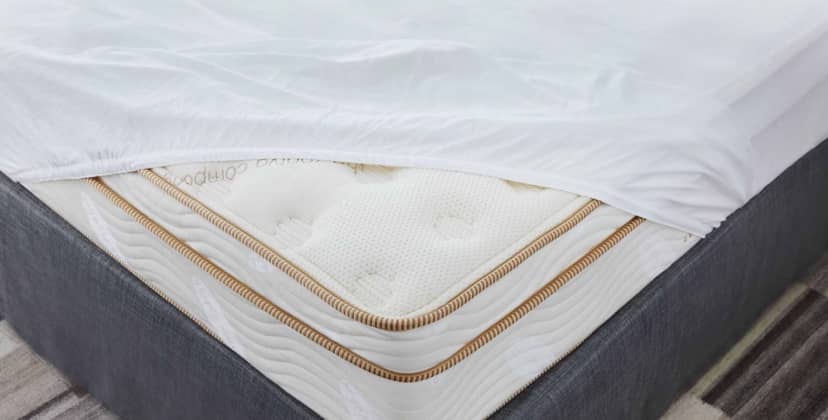
Price
$145
Material
Organic cotton with polyurethane moisture barrier
Full Details
The Saatva Waterproof Mattress Protector checks a lot of boxes for people who want to safeguard their sleep surface against spills and stains. A non-rubber waterproof barrier ensures excellent protection from liquids of all types, but the membrane shouldn’t trap too much heat. The outer shell is composed of breathable organic cotton for added cooling, and the fabric has moisture-wicking properties if you’re prone to sweating in bed.
The cotton is Fair Trade certified, which indicates Saatva follows guidelines for ethical worker treatment and compensation at the company’s processing facilities. You may wash and dry the protector in any household machine whenever it needs to be cleaned. The perimeter is equipped with an elastic silicone band to help the protector fit snugly around your mattress, and a pocket depth of 16 inches makes it compatible with most models sold today.
Saatva provides free ground shipping throughout the contiguous U.S. The Waterproof Mattress Protector comes with a 45-night trial period, during which you may return the item if you aren’t satisfied – though the company requests that you launder it prior to sending it back. Your purchase will also be backed by a 1-year warranty.
Best Value
Helix Waterproof Mattress Protector
The Helix Mattress Protector safeguards your sleep surface from spills and stains, and also provides additional cushioning with plush fiber fill. A below-average sticker price, free shipping throughout the contiguous U.S., and a generous 100-night trial make this protector a great option for shoppers with limited budgets.
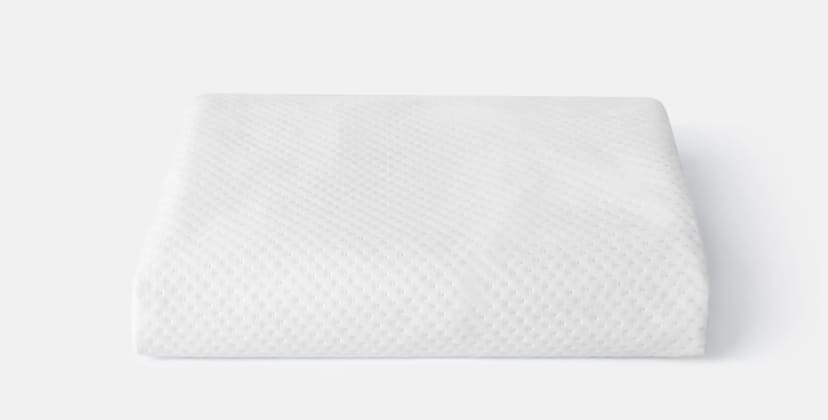
Price
$104
Material
100% polyester panel and skirting with TPU waterproof membrane
Full Details
Most mattress protectors are designed for the sole purpose of safeguarding your sleep surface from liquid damage and contaminants. To this point, the Helix Waterproof Mattress Protector is highly effective, but top and side panels made of knit polyester also feel exceptionally soft. We recommend the protector to anyone who wants to add a bit of cushioning to their mattress surface. The fabric also limits noise, breathes well, and provides enough traction to prevent slippage during the night.
Thick elastic banding secures the protector to the corners of your mattress, and a 15-inch pocket depth makes it compatible with most mattresses sold today — even some high-profile models. A membrane of waterproof TPU material repels fluids without absorbing too much heat. You may wash and dry the protector in any household machine whenever it needs to be cleaned.
Affordable pricing and free shipping to all 50 states makes the Waterproof Mattress Protector a good option for shoppers with limited budgets. Helix Sleep also allows you to test the protector for up to 100 nights before deciding to return it or keep it. Comparatively, most brands do not offer any sort of trial period for mattress protectors. Your purchase is further backed by a 1-year manufacturer’s warranty.
Most Comfortable
Nolah Bamboo Mattress Protector
The Nolah Bamboo Mattress Protector is composed of breathable, moisture-wicking fabric to help you stay cool and dry while safeguarding your sleep surface. A crinkle-free moisture barrier adds to the comfortable design.
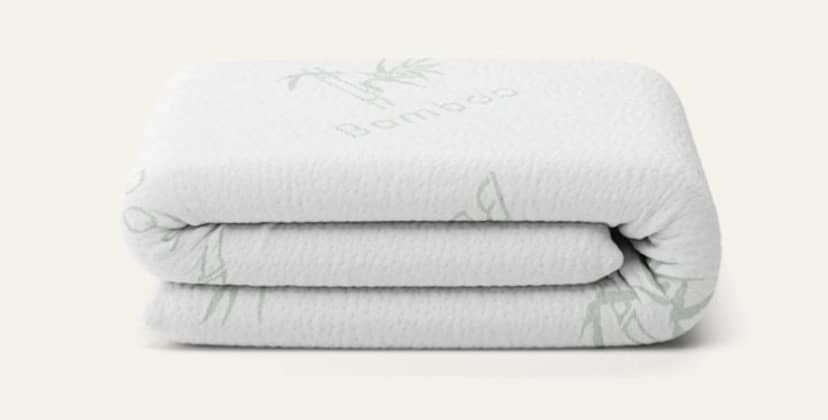
Price
$89
Material
60% polyester, 40% viscose derived from bamboo
Full Details
Waterproof mattress protectors can feel stiff and produce a crinkly sound when you lay down, but the Nolah Bamboo Mattress Protector has a soft feel that reduces noise. The protector is also designed with cooling properties to keep a comfortable temperature throughout the night.
The protector features a 60% polyester and 40% bamboo-derived viscose fabric blend. This material is naturally breathable and moisture-wicking, great for hot sleepers or those who reside in humid areas. A thin TPU layer underneath blocks liquids or moisture from reaching the mattress. The soft bamboo blend top layer helps offset any crinkling sounds created from this waterproof underlayer. This protector is thin, so it should not affect the feel of a mattress.
Six standard size options are available – twin, twin XL, full, queen, king, and California king. The protector’s pocket can fit mattresses up to 15 inches thick, and you can wash it in a household washing machine for easy care.
Nolah offers free shipping to the contiguous U.S. and a 30-day return policy. A 10-year warranty backs bamboo Mattress Protector purchases.
Best Cooling
Brooklyn Bedding Luxury Cooling Mattress Protector
If you’re looking for a protector that safeguards your mattress without compromising breathability, the Luxury Cooling Mattress from Brooklyn Bedding checks both boxes. Proprietary phase change fabric dissipates heat on contact and feels cool to the touch at all times.
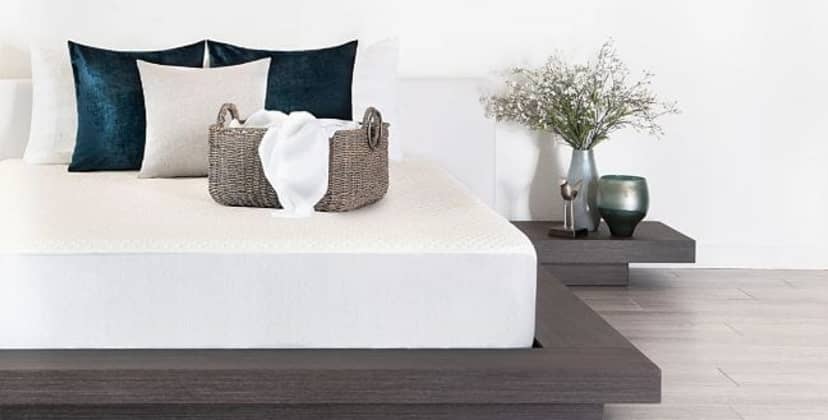
Price
$99
Material
Polyester, TitanCool fabric, and waterproof polyurethane membrane
Full Details
Many waterproof protectors sleep a bit warm because their polyurethane membranes absorb and trap body heat. The Luxury Cooling Mattress Protector from Brooklyn Bedding bucks this trend and lives up to its name thanks to breathable composition that includes proprietary TitanCool fabric, which draws heat away from the surface to help you stay comfortable. Fortunately, this does not diminish the protector’s ability to safeguard against spills and liquid damage.
The protector is also hypoallergenic and can effectively stave off dust mites, bacteria, and bed bugs. Since the corners are elasticated, the protector can be pulled snugly over your mattress like a fitted sheet. The recommended mattress thickness is 11-14 inches.
To clean the protector, simply machine wash in cool to warm water and then tumble dry on a low setting. Six sizes are available ranging from twin to king and California king, ensuring compatibility with any standard mattress dimensions.
Brooklyn Bedding offers free shipping anywhere in the contiguous U.S. The reusable packaging doubles as a handy storage case. You may test out the protector and return if not satisfied for up to 30 days after placing your order. The purchase is also backed by a 3-year warranty against certain defects.
Best Waterproof
Sweet Zzz Cooling Mattress Protector
Many protectors on the market are waterproof, but this model from Sweet Zzz is constructed from Tencel lyocell, a highly absorbent material that pulls moisture from your body. Add in a polyurethane laminate layer and you’ve got a protector that safeguards your mattress from every possible contaminant.
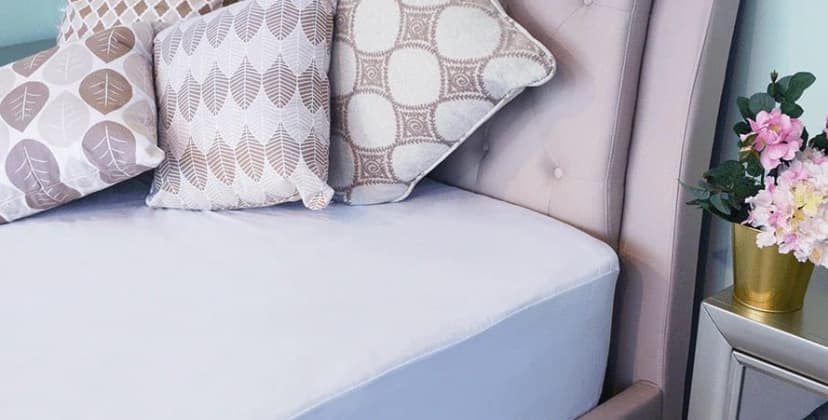
Price
$59
Material
Tencel lyocell and waterproof polyurethane membrane
Full Details
The Sweet Zzz Cooling Mattress Protector helps keep both the sleeper and the mattress dry.
Eucalyptus-based Tencel lyocell makes up the top part of the protector. Not only is this material breathable and cool-to-the-touch, but it is also extremely absorbent, pulling excess moisture away from the sleeper’s body. While the Tencel top wicks away liquids, polyurethane lamination underneath ensures they don’t seep down into the bed. This construction makes the protector quiet and durable, but the Tencel could pill over time.
The Sweet Zzz Cooling Mattress Protector is hypoallergenic and acts as a barrier against liquids, dust mites, and allergens. With its fitted-sheet-style design, the protector covers the surface and four sides of the mattress. The silky smooth Tencel is gentle on sensitive skin, and the protector holds OEKO-TEX certification for product safety standards.
All six standard mattress sizes are available and should accommodate models between 10 and 14 inches thick. A 10-year limited warranty covers qualifying defects, while a 50-day trial period lets customers try the protector at home to decide if it’s right for them.
Best Luxury
Pure Parima Egyptian Cotton Mattress Pad
Composed of a luxurious Egyptian cotton shell and plush down alternative fill, this mattress pad from Pure Parima significantly improves how soft and comfortable your sleep surface feels. A generous pocket depth also means you can use the pad with virtually any mattress sold today.

Price
$189
Full Details
Pure Parima’s Egyptian Cotton Mattress Protector brings luxurious design to an everyday bedding staple. The quilted shell is made of pure Egyptian cotton, a fabric prized for its natural longevity, softness, and cooling properties. A Cotton Egypt Association certification confirms the material’s authenticity as being entirely sourced from the Nile River Valley. Down alternative fill makes the protector a good option if you want your sleep surface to feel a bit plusher. Diamond-stitch baffles help ensure even fill distribution.
Although the protector is not waterproof, its thick profile should provide a secure barrier between you and your mattress. The elasticated corners offer generous pocket depth, allowing you to use the protector with any mattress up to 18 inches thick — a range encompassing the vast majority of models sold today. Queen and king sizes are available. The protector is fully machine-washable for quick and easy care, and your order includes a dust-proof pouch for storage when not in use.
Given its high-end materials and long-lasting construction, the Egyptian Cotton Mattress Protector is reasonably priced. Pure Parima also offers free ground shipping to all 50 states, but you can pay extra for expedited delivery. All purchases include 100-night sleep trials. Complimentary returns are honored during this time frame if you aren’t satisfied with the protector.
Softest
Naturepedic Organic Waterproof Mattress Pad
The Naturepedic Organic Waterproof Mattress Pad is luxuriously soft, safeguarding your mattress from liquid damage while making your sleep surface feel more comfortable and inviting. The pocket depth range covers the vast majority of mattresses sold today, and a GOTS certification ensures the protector is produced using eco-friendly means.
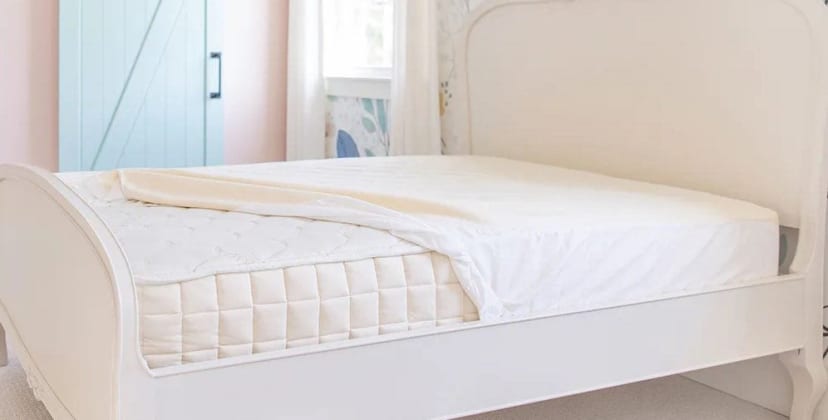
Price
$159
Full Details
A common complaint about mattress protectors is that they make sleep surfaces feel uncomfortable, but that shouldn’t be an issue with Naturepedic’s Organic Waterproof Mattress Pad. The design features a thick shell made of soft organic cotton that’s similar in feel to a standard bed sheet. A thin waterproof membrane inside the protector safeguards your mattress from spills and stains without trapping heat or producing noise when you move in bed.
The cotton has earned certification from the Global Organic Textile Standard, a leading worldwide authority for recognizing sustainably sourced fabrics. Organic cotton is also highly breathable, so this protector is suitable for hot sleepers and those who reside in warm or humid environs. Thick elastic skirting along the perimeter holds the protector in place during the night. A pocket depth of 9 to 16 inches means it’s compatible with most leading mattresses made today. The protector can be washed and dried in any household machine.
Approachable pricing, above-average durability, and free shipping within the contiguous U.S. should all appeal to shoppers seeking a high-value purchase. Your purchase also includes a lengthy trial and return period spanning 100 nights in length. If you decide to keep the Organic Waterproof Mattress Pad, it’s further backed by a one-year manufacturer’s warranty covering various structural and material defects.
Best Airflow
Layla Cooling Mattress Protector
The Layla Cooling Mattress Protector promotes airflow and feels cool to the touch at all times — many competing protectors fall short on both counts. Proprietary phase change fabric dissipates heat on contact to keep you comfortable in any climate.
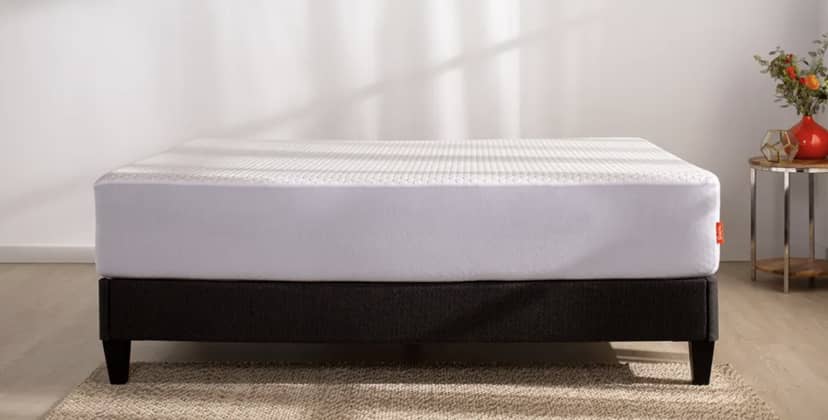
Price
$129
Material
Polyester
Full Details
If you’ve had bad luck finding a waterproof barrier for your mattress that doesn’t retain too much heat, we recommend the Layla Cooling Mattress Protector. As our testing team learned, this protector truly lives up to its name — the fabric is cool to the touch, and the internal membrane is thin enough to resist heat buildup. Even in hot or humid conditions, the Cooling Mattress Protector is effective at maintaining a comfortable temperature.
The fabric is not only liquid-proof, but also hypoallergenic and resistant to stains and dust mites. Regular cleaning can further ensure your mattress stays hygienic, and the protector is easy to keep clean — simply wash and dry in your household machines. The elastic skirting can accommodate any mattress up to 14 inches thick. We recommend measuring your mattress to ensure a proper fit. The protector is available in all six standard mattress sizes.
A below-average sticker price and free shipping throughout the contiguous U.S. make the Cooling Mattress Protector a solid choice for shoppers with limited budgets. Layla also allows you to test it for up to 30 nights before deciding whether to return it for a refund or keep it. If you opt for the latter, you’ll also receive a one-year warranty that covers manufacturing defects.
Best All-Season
Puffy Mattress Protector
A shell made of smooth, sateen-woven rayon derived from bamboo makes the Puffy Mattress Protector feel softer and more comfortable than many competing models. This breathable fabric also offsets heat retention to keep you cool throughout the calendar year.
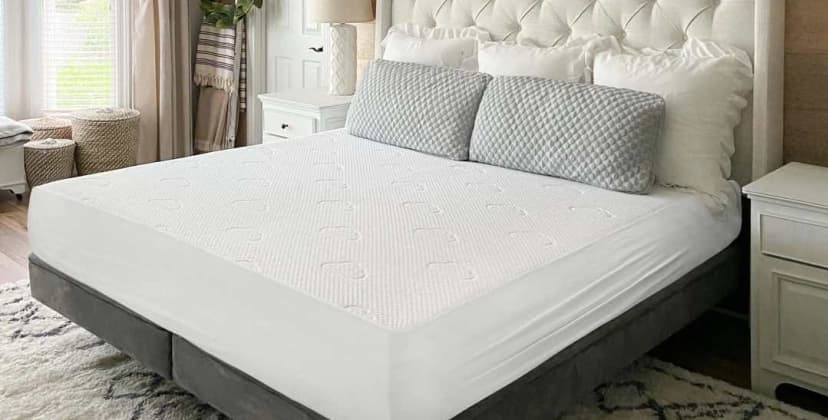
Price
$128
Material
Rayon derived from bamboo
Full Details
The Puffy Mattress Protector is designed with comfort and cooling in mind, making it an ideal protector for your mattress through all four seasons.
The protector has a waterproof design that protects mattresses from spills, stains, and nighttime accidents. Many waterproof protectors can feel stiff or crinkly, but this model is made with a bamboo-derived rayon fabric that is soft to the touch and makes little noise when you move around. The fabric also has natural cooling properties, offering better ventilation than some competing waterproof protectors.
The Puffy Protector secures to your mattress with elasticated pockets that are 15 inches deep, so it should be compatible with most mattresses. It’s available in twin, twin XL, full, queen, king, and California king sizes. You may machine wash in cold water on a gentle setting and tumble dry on low heat.
Puffy offers customers a 101-night sleep trial and lifetime warranty. Shipping is free to addresses in all 50 states.
Best Deep-Pocket
Nest Bedding Cooling Cotton Mattress Protector
With an impressive pocket depth of 18 inches, the Nest Bedding Cooling Cotton Mattress Protector is compatible with nearly every mainstream mattress sold today. Excellent breathability, effective waterproofing, and an approachable sticker price round out the appealing design.
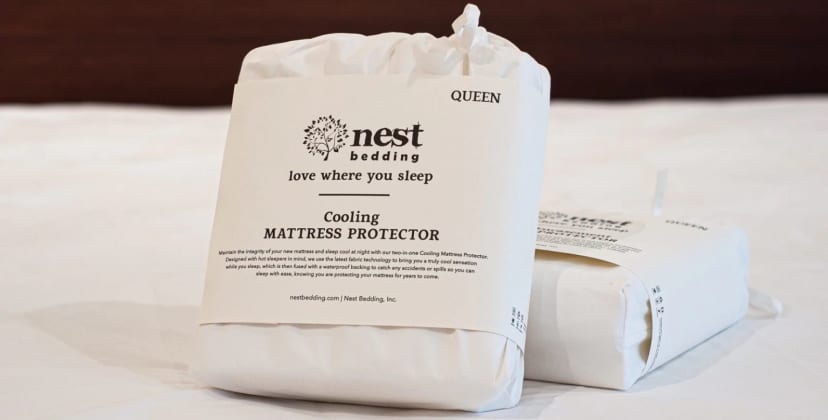
Price
$71
Material
Cotton top with polyester, spandex, and waterproof polyurethane lamination
Full Details
The Nest Bedding Cooling Cotton Mattress Protector caters to sleepers who need waterproof protection for themselves or their children but don’t enjoy the stiff feel that typically comes with moisture-proof fabric. A soft cover makes the mattress protector feel more comfortable, while breathable materials prevent heat retention.
The protector features a breathable cotton cover, polyester and spandex skirt, and waterproof polyurethane lining. You can choose between a five-sided protector that covers the mattress surface, or a full encasement option for extra protection. Both options greatly reduce mattress damage from liquids, dust, or dirt.
Six standard sizes are available: twin, twin XL, full, queen, king, California king. The protector accommodates mattresses up to 18 inches thick, which is compatible with most beds in our testing lab. The protector is fully machine-washable for easy care. Nest Bedding ships free to the contiguous U.S., and returns are accepted within 30 nights.
Best Overall
Saatva Waterproof Mattress Protector
A soft, breathable protector that’s effective at safeguarding your mattress from spills and stains.
See More Details

Best Value
Helix Waterproof Mattress Protector
A wallet-friendly mattress protector that doesn’t skimp on quality of materials or design.
See More Details

Most Comfortable
Nolah Bamboo Mattress Protector
A comfy mattress protector made of breathable, moisture-wicking viscose derived from bamboo.
See More Details

Best Cooling
Brooklyn Bedding Luxury Cooling Mattress Protector
A breathable mattress protector that feels cool to the touch and dissipates body heat on contact.
See More Details

Best Waterproof
Sweet Zzz Cooling Mattress Protector
A waterproof pad that provides maximum protection for your sleep surface.
See More Details

Best Luxury
Pure Parima Egyptian Cotton Mattress Pad
A high-end mattress protector made from luxurious, long-lasting Egyptian cotton.
See More Details

Softest
Naturepedic Organic Waterproof Mattress Pad
A remarkably soft mattress pad that provides first-rate protection against spills and stains.
See More Details

Best Airflow
Layla Cooling Mattress Protector
A breathable protector that safeguards your mattress while minimizing heat buildup.
See More Details

Best All-Season
Puffy Mattress Protector
A soft waterproof mattress protector made of breathable, moisture-wicking rayon derived from bamboo.
See More Details

Best Deep Pocket
Nest Bedding Cooling Cotton Mattress Protector
A soft cotton mattress protector with deep pockets to accommodate high-profile beds.
See More Details

Best Mattress Protectors Video
Watch our video below to learn more about our top mattress protector picks. We’ll take a closer look at the construction and performance of each protector.
In-Depth Mattress Protector Guides
For more personalized mattress protector guides, check out the following pages:
What Is a Mattress Protector?
A mattress protector is an extra layer between the fitted sheet and the mattress that defends against dirt and damage. Many protectors also have waterproofing to prevent issues like mold and mildew that could arise from the moisture of sweat, spills, and accidents. While most mattress protectors rest on top of the bed, some wrap all the way around for more comprehensive protection.
In addition to safeguarding the mattress, protectors may also shield the sleeper from irritants that could already reside in the mattress, like allergens, mold, and dust mites.
Mattress protectors, mattress pads, and mattress toppers all typically rest on the surface of a mattress, but they perform different tasks. A mattress protector’s main purpose is to act as a buffer between the sleeper and their bed, though some may alter the feel slightly with cooling effects or added softness.
On the other hand, pads and toppers help alter the feel of the mattress. Pads are thinner for a bit of extra cushioning, while toppers are thicker for a more significant adjustment. Like protectors, pads and toppers can also enhance the lifespan of your mattress, but they do so by preventing some of the normal wear and tear associated with regular use.
How to Choose a Mattress Protector
Most shoppers don’t put as much thought into the purchase of a mattress protector as they do into their bed, sheet, and pillow selections. However, the right protector can improve your sleep experience and enhance the life expectancy of your mattress, so it’s worth the effort to find the best option for you.
What to Consider When Purchasing a Mattress Protector
We’ll explain the top things to look for when selecting a mattress protector. These criteria can affect the comfort, performance, convenience, and level of protection.
Price
A mattress protector is just one component of your sleep setup, so selecting an option within your budget is important. On average, mattress protectors usually cost between $50 and $100. However, this will vary based on their materials and construction. Some protectors with additional features, like padding and/or cooling, may cost more, while more basic protectors often cost less.
When assessing the cost, you should also consider the level of protection. Even if the initial price seems high, a mattress protector that significantly extends the life expectancy of your mattress could ultimately save you money. Similarly, protectors with cooling features and padding frequently cost more, but they often do the job of both a protector and a pad or topper, so they may be more affordable than purchasing two separate components.
Waterproofing
While not all mattress protectors are waterproof, most are. A waterproof protector may be ideal for children prone to accidents, anyone who tends to sweat, and those who like to eat or drink in bed.
Quality Materials
High-quality materials may better shield your mattress and ensure that nothing sneaks through. Additionally, protectors made of high-quality materials should hold up well to regular washings so that you can refresh your sleep surface without needing to replace the protector as often.
Cooling Properties
Some protectors are built to cool the sleep surface. They generally use special cooling components, like phase change material or eucalyptus fiber. These options may appeal to hot sleepers and those living in warm climates.
Warranty
Many mattress protectors come with warranties that provide recourse if a qualifying defect occurs. Most warranty policies come at no additional charge, so they’re a nice bonus for buyers.
Noise
While protectors are often designed to be quiet or completely silent, some could produce noise when the sleeper moves. This is more likely with waterproof protectors because of their backing. Paying attention to the materials, construction, product description, and customer reviews may give you a better idea of a protector’s noise potential.
What Are the Benefits of a Mattress Protector?
A mattress protector could have many advantages depending on its build and materials. We’ll highlight some of the most common potential benefits.
Mattress Protection: As the name suggests, the main duty of a mattress protector is to guarantee that your mattress is protected while still allowing the mattress to breathe. However, what it protects against will depend on the protector itself. Some shield against dirt, debris, and allergens. Others protect against sweat and other liquids, and some defend against dust mites and bed bugs. Using a mattress protector virtually eliminates the bacteria that would otherwise be accumulating on your mattress every night.
Reduction in Allergens: Allergens can permeate the surface of a mattress, and since mattresses are usually spot-clean only, it can be virtually impossible to get them out. A protector could stop many allergens from reaching the bed. Most protectors are machine washable, so you can easily freshen up the sleep surface and remove allergens that accumulate. Even if your mattress already contains allergens, the right mattress protector might help isolate them so that they don’t interfere with your sleep.
Durability/Lifespan of Mattress: A waterproof protector can prolong the life of a mattress by preventing damaging liquids from reaching the bed. Moisture can foster mold growth, cause stains, and deteriorate the material, thus jeopardizing comfort and hygiene. Protectors that are not waterproof can also keep a mattress usable longer by limiting dust mites, allergens, and dead skin from accumulating.
Cost Effectiveness: Since protectors typically cost significantly less than a new mattress, they can be a cost-effective way to prolong the life of your bed so that you don’t have to replace it as often.
Ease of Cleaning: Care instructions vary between protectors, but they are generally machine-washable for easy cleaning.
While mattress protectors can provide many benefits, they may not be ideal for all sleepers. For individuals who want to adjust the feel of their bed, the biggest drawback may be that most mattress protectors do not provide much if any cushioning. Some padded protectors are available, but most sleepers who are primarily interested in adjusting the feel of their bed will prefer a topper or pad.
Additionally, protectors may help extend the lifespan of your mattress, but they can’t prevent all wear and tear. Depending on their construction, some protectors could also make noise when you move.
Frequently Asked Questions
Do I need a mattress protector?
While mattress protectors are not essential and you can use your bed without one, they are an inexpensive way to keep your bed cleaner and prevent long-term damage from liquids. This makes them a good investment for most sleepers. Additionally, many mattress warranty and/or trial policies either require the use of a mattress protector or are voided if the mattress develops stains or other evidence of damage.
How does the mattress protector attach to the bed?
How the mattress protector attaches to the bed depends on the model. Most options affix like a fitted sheet with elastic around the perimeter to hold them in place. However, encasement-style protectors are also available that wrap around the whole mattress and zip shut for full coverage.
Are all mattress protectors waterproof?
The vast majority of mattress protectors are waterproof, but some may not be. Many manufacturers will label the product as a “mattress pad” rather than a “mattress protector” if it isn’t waterproof. However, if protection from liquids is important to you, it’s best to look for an option designed for spills and accidents.
Can mattress protectors adjust the firmness of my bed?
Mattress protectors are generally thin, so they’re unlikely to affect the firmness of the bed. However, some protectors have a bit of cushioning, which could make a bed feel slightly softer. If you’re looking to adjust the firmness of your bed, a mattress topper may be a better choice.
How do I clean my mattress protector?
Owners should clean their mattress protector following the manufacturer’s care instructions to prevent damage. Most protectors can be machine washed in warm or cold water on the gentle cycle with mild detergent and tumble dried on low heat.
Can I iron my mattress protector?
Most waterproof protectors use backing that could be damaged by high heat, so ironing usually isn’t advisable.
Does a mattress protector prevent dust mites or bed bugs?
The level of protection against dust mites and bed bugs varies between mattress protectors. Encasement-style protectors are more likely to shield against these pests than fitted-sheet-style options because they wrap around the whole mattress. However, if dust mite and bed bug protection is a priority, you should look for options specifically designed for the task.
What’s the difference between a mattress protector and a mattress topper or mattress pad?
Purpose and thickness are the main differences between a mattress protector, a mattress pad, and a mattress topper. A mattress protector is traditionally thin and engineered to shield your mattress from dirt, bacteria, and allergens. Mattress pads usually add a bit of cushioning and comfort but are not built for protection. Toppers are thicker layers intended to alter the softness or firmness of your mattress.

Still have questions? Ask our community!
Join our Sleep Care Community — a trusted hub of product specialists, sleep health professionals, and people just like you. Whether you’re searching for the perfect mattress or need expert sleep advice, we’ve got you covered. Get personalized guidance from the experts who know sleep best.
